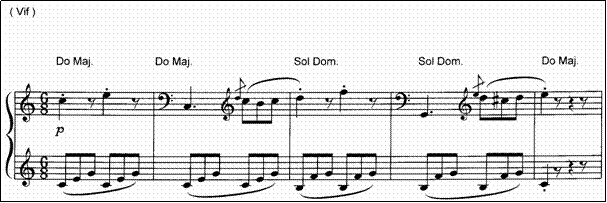1. Examples and analysis
a. Scherzo in C minor ( Alberti ) :

The left hand accompaniment plays a 3 eighth notes 'legato' in arpeggio for 1 beat of this compound measure.
The chosen notes belong to the perfect C major chord (bars 1 & 2), in other words, the root (C), the major 3rd (E) and the perfect 5th (G).
Bars 3 & 4 show a dominant 7th chord (G - B - D - F), on 1st inversion (B - D - F - G), without the right hand 'D' (B - F - G).
The C and G notes in bass clef (bars 2 & 4), cross the left hand in order to give the real root of the chord.
Both hands have complementary le-rythmes (1 quarter note VS 3 eighth notes), but sometimes, they use the same le-rythme (bars 2 & 4).
The left hand accompaniment is written with a treble clef, and placed very close to the melody. This allows a homogeneity and a lightness, in the high-medium register.
b. Clair obscur ( Yves feger ) :

The left hand plays arpeggios in sixteenth notes on a Db major chord (1st beat), a F minor (2nd beat) and a Fb major on 1st inversion (3rd beat).
These arpeggios are more distant from each other and are based on the 3 main notes of the perfect triad (root - 5th - root - 3rd, etc…).
Let us notice that the right hand melody is harmonized in 3rd, and supports the left hand harmony.
Like previously, the relationships between the melody and the basses of the chords are complementary, mainly with an harmonic interval of 3rd or 5th.
Finally, the basses placed on beats 1,2 and 3 also give an arpeggio and create a kind of counter melody below the right hand main theme.
c. 5th invention 3 voice ( J.S. Bach ) :

First of all, let's notice the perfect le-rythmeic complementary between both hands, a kind of 'passive / active' conversation.
The left hand is playing a 3 sixteenth note arpeggio on the offbeat, followed by 2 quarter notes. This repeated motive (ostinato) seems to be continuous and allows a frequency of 2 chords per bar: (e.g. 1st bar : Eb major on beats 1 & 2 / C minor on beat 3).
These arpeggios notes make a traditional perfect chord organized in 3rds.
The two quarter notes in the accompaniment, create a relief to the right hand theme, just like the 'french style' openings.
d. rondo opus1 ( F. Chopin ) :

In this case, the accompaniment is successively played by both hands with a spaced arpeggio on a Db perfect major chord, followed by an Ab dominant 7th chord on 1st inversion (C - Eb - Gb - Ab).
Here, the right hand theme is no longer than a 2 beat duration (bar 2 / beat 2 & bar 3 / beat 1), and perfectly fits the arpeggio.
The accompaniment is flowing over almost 4 octaves.